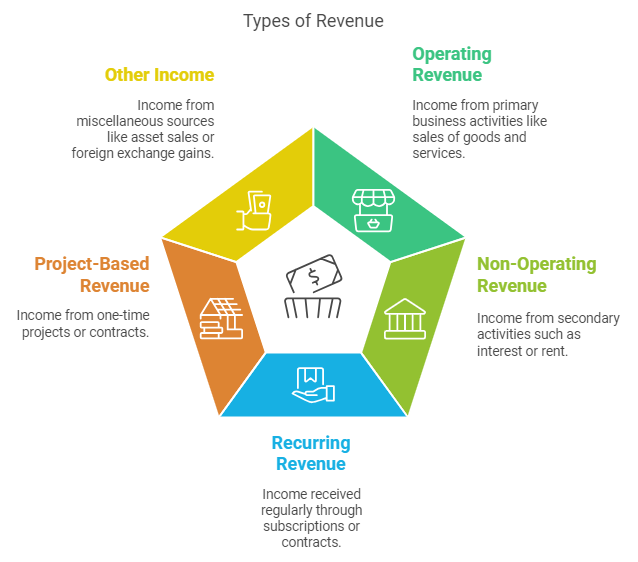A thorough understanding of annual revenue is critical for any business owner or financial enthusiast since it represents a company's total income from its sales and other sources within a year. However, many still find it quite challenging to understand what separates annual revenue from profit and why this figure is vital for a company’s financial health.
Hence, to guide Philippine individuals and businesses the right way, this article will aim to clarify all the common revenue confusion regarding annual revenue in the Philippines by exploring its definition, calculation methods, and the difference between revenue and profit.
Additionally, they will also learn about the different revenue types and how accounting methods can affect revenue reporting. So, if this sounds interesting to you, let's dive in and explore all the various facets of annual revenue in the Philippines.

Annual Revenue Meaning And Importance in The Philippines

Annual revenue is a business's total income from its operations over 12 months. It includes money earned from product sales, services rendered, and other business activities before deducting expenses like taxes or operational costs.
The figure often prominently appears as the 'top line' on a company's financial statements, distinguishing it from profits resulting from deducting expenses.
Here, take a look at the importance of annual revenue for businesses and individuals in the Philippines -
1. Business Growth Assessment
Annual revenue helps businesses track their year-on-year performance, enabling them to measure growth and adjust strategies for sustainable success.
2. Financial Planning and Budgeting
Annual revenue provides a foundation for effective financial planning, ensuring the proper allocation of resources and investments for both businesses and individuals.
3. Attracting Investors
For businesses, higher annual revenue can attract investors by showcasing profitability and market potential, increasing opportunities for funding and partnerships.
4. Tax Compliance
For individuals and companies in the Philippines, annual revenue plays a crucial role in tax reporting, ensuring compliance with the Bureau of Internal Revenue (BIR) and avoiding penalties.
5. Loan Eligibility
Banks and lending institutions in the Philippines assess annual revenue to determine eligibility for business or personal loans, ensuring borrowers can manage repayments.
Also Read: 6 Steps to Apply and Get a Business Loan
How to Calculate Annual Revenue in The Philippines
Annual revenue is calculated by summing up a business's yearly income. The formula is as follows -
Annual Revenue = Number of Units Sold × Price Per Unit
Here’s how to calculate it -
- Identify Total Sales: Determine the total number of products sold or services provided annually.
- Calculate Sales Price: Multiply the total units sold by the price of each unit.
- Include Other Income Sources: If applicable, add any additional income streams, such as interest or rent.
For example, if a company sells 10,000 products at PHP 500 each, the annual revenue is 10,000 x 500 = PHP 5 million. This method helps businesses in the Philippines assess their financial health and growth potential.
For accurate financial tracking, include all sources of income and ensure calculations align with Philippine tax and financial reporting standards. Tracking your service's subscribers and average revenue per user can offer deeper insights into your business's long-term earning potential.
Are you still unclear about the actual role and concept of annual revenue? Check out this video. It clarifies the concept and calculation of revenue in business and offers insights into how revenue operates as an organization's lifeblood.
Also Read: Types and Methods of Inventory Management Systems with Examples
Types of Revenue in The Philippines
In the Philippines, businesses generate different types of revenue based on the nature of their operations. Each type of revenue reflects how a company earns its income, impacting its overall financial reporting and planning mechanism.
Here are the common types of revenue generated in the Philippines -

1. Operating Revenue
This is income generated from a company’s primary business activities, such as selling goods or services. For example, retail stores earn revenue from product sales, while service-based businesses earn from providing their services.
2. Non-Operating Revenue
Revenue earned from secondary or indirect activities. This can include interest income, dividends, or rent. Non-operating revenue is typically irregular and not tied to core operations.
3. Recurring Revenue
Income that a business receives regularly, often through subscription models or long-term service contracts. Examples include telecom companies earning monthly from customer subscriptions.
4. Project-Based Revenue
Generated from one-time projects or contracts. Businesses in construction or consulting may earn revenue after completing a specific project.
5. Other Income
This includes earnings from miscellaneous sources, such as gains from the sale of assets, foreign exchange gains, or insurance claims. While important, these are less consistent forms of revenue.
Annual revenue is an essential metric for businesses and individuals to track, but accurately estimating it is another challenge. To learn more about these challenges, check out this Reddit thread. Here, a Reddit user shares their challenge in forecasting annual revenue for a business with assumed monthly recurring revenue growth.
Also Read: Understanding Positive Cash Flow: Meaning, Importance, and Strategies to Generate It
Accounting Methods Used And Its Impact on Revenue Calculation in The Philippines

It is no secret, but it is widely known that a business's accounting method impacts how it calculates and reports revenue, influencing its financial statements and tax compliance.
The two primary accounting methods used in the Philippines are cash basis and accrual basis. Each method affects the timing of revenue recognition, which can significantly alter how financial performance is presented.
Here, take a look at how they work in the Philippines -
Cash Basis Accounting
In cash-basis accounting, revenue is recorded only when cash is received, and expenses are recorded when payments are made. This method is more straightforward and often used by smaller businesses.
Its advantage is that it reflects actual cash flow. Still, it may only provide an accurate picture of financial performance if large amounts of revenue are earned and still need to be collected within the reporting period.
However, If payments are delayed, cash-basis accounting can understate revenue during periods of high sales. As a result, businesses may appear less profitable in their financial reports than they genuinely are.
Accrual Basis Accounting
Accrual accounting records revenue when it is earned, even if not yet received, and expenses when they are incurred, even if not yet paid. This method is generally required for larger businesses and provides a more accurate view of financial performance by matching revenue with the related expenses in the period they occur.
Accrual accounting presents a more accurate and comprehensive picture of a company’s financial health but may not reflect actual cash flow. Businesses might appear highly profitable even if they face cash shortages due to delayed client payments.
Also Read: Easy Business Loans and Financing Options for Small Businesses and Startups
Difference Between Revenue and Profit in The Philippines
Revenue and profit are both key financial terms used to assess a business’s economic performance, but they serve different purposes. Hence, understanding these distinctions is crucial for a company's proper financial management and reporting in the Philippines.
Here, take a look at the core distinction between revenue and profit in the Philippines -
Revenue
Revenue is the total income a business generates from its core operations, such as sales of goods or services before any expenses are deducted. For example, a retail shop's revenue is the total amount earned from selling products.
Revenue provides an overview of a business's gross earning capacity, but it must be noted that it does not account for the costs associated with generating those earnings.
Profit
Conversely, profit is the amount of income left after all expenses, taxes, and costs of goods sold (COGS) have been deducted from the total revenue. Profit can be further categorized into gross profit, operating profit, and net profit, each reflecting a different level of earnings after certain expenses are accounted for.
Essentially, profit clarifies the business’s financial health by showing how much money is retained after covering all operational costs.
Hence, it is fair to summarize that while revenue shows a business’s total income, profit reveals its financial efficiency and sustainability, making both metrics essential for evaluating a business's success in the Philippines.
To illustrate the main difference between the two, with the help of an example, consider a company with an annual revenue of PHP 100k. If it incurs PHP 30k in COGS, PHP 20k in operating expenses, and PHP 10k in non-operating costs, the company’s profit would be PHP 40k.
Conclusion
To conclude, as we have seen from this article, thoroughly understanding and accurately calculating annual revenue is essential for businesses in the Philippines as it provides them with a precise measure of their financial performance.
One core advantage of knowing annual revenue is that it helps with internal decision-making and external factors like tax compliance, attracting investors, and securing loans.
The best way for companies to calculate their annual revenue is to assess their growth and profitability, and they can do this by using the correct formula. This formula involves multiplying the number of units sold by the price per unit and ensuring all revenue streams are accounted for.
Moreover, conducting clear and precise revenue calculations further enables businesses and individuals to plan their finances better and pave the way for sustainable business growth. Doing so is not only pivotal for internal assessments but also assures potential investors and lenders of the business’s viability.
Frequently Asked Questions (FAQs)
1. What’s the difference between annual revenue vs. net income?
The main difference between annual revenue and net income is what they represent. Annual revenue is a business's total income from its operations before deducting any costs.
In contrast, net income is the profit remaining after all expenses, taxes, and costs of goods sold are subtracted from the revenue.
2. What’s the main difference between a business's annual revenue vs. gross income?
The main difference between annual revenue and gross income lies in what they account for. Annual revenue is a business's total annual income from its operations.
Gross income, on the other hand, is the revenue minus the cost of goods sold (COGS), representing the income a business retains before other operating expenses, taxes, and interest are deducted.
3. What are the 5 examples of revenue?
Here are 5 examples of revenue generated in the Philippines -
- Product Sales: Income generated from selling physical goods, such as electronics or clothing.
- Service Revenue: Earnings from providing services, like consulting or repairs.
- Subscription Fees: Regular income from customers subscribing to services (e.g., Netflix).
- Interest Revenue: Income from interest earned on savings or investments.
- Rental Income: Money earned from leasing properties or equipment.
4. How do you show annual revenue?
To show annual revenue, you can list it on the income statement under the "Revenue" or "Sales" section. This includes the total income generated from selling goods or providing services within a fiscal year before deducting expenses.
Annual revenue is typically presented at the top of the income statement to provide a snapshot of a company's earnings over the year.













